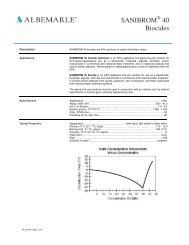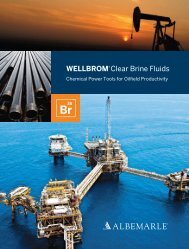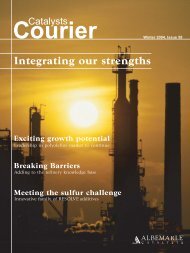Emissions in Remission - Albemarle Corporation
Emissions in Remission - Albemarle Corporation
Emissions in Remission - Albemarle Corporation
Create successful ePaper yourself
Turn your PDF publications into a flip-book with our unique Google optimized e-Paper software.
Achiev<strong>in</strong>g greater profitability with<br />
opportunity feeds <strong>in</strong> the FCC unit<br />
Opportunity feeds can be characterized as hav<strong>in</strong>g concarbon, nitrogen, aromaticity, contam<strong>in</strong>ant metals levels,<br />
or boil<strong>in</strong>g ranges much different from a typical vacuum gas oil (VGO). Examples <strong>in</strong>clude gasol<strong>in</strong>e, diesel,<br />
distillates, light cycle oil (LCO), resids, slurry, coker stocks, visbreaker and deasphalted oils.<br />
With a wide range of crackability and coke-mak<strong>in</strong>g tendency,<br />
opportunity feeds can present serious process<strong>in</strong>g challenges.<br />
The penalty <strong>in</strong> yields for process<strong>in</strong>g some of these feeds can be<br />
very high, and the best medic<strong>in</strong>e to limit these problems is the<br />
use of the proper catalyst technology.<br />
The challenges <strong>in</strong>volved <strong>in</strong> process<strong>in</strong>g opportunity feeds can<br />
<strong>in</strong>clude high coke formation tendency, poor crackability, high<br />
levels of metals contam<strong>in</strong>ation, heav<strong>in</strong>ess of the feed<br />
<strong>in</strong>hibit<strong>in</strong>g feed/catalyst contact, and a challenge to upgrade<br />
the heavy molecules 1.<br />
Two key formulas<br />
Two key relationships <strong>in</strong> understand<strong>in</strong>g the impact of crack<strong>in</strong>g<br />
opportunity feeds are often simplified and summarized as<br />
follows:<br />
Formula 1:<br />
Coke yield ~ a*ConCarbon + UF coke [ (b*FF coke)*(c*PV coke)*<br />
(d*Activity coke)]<br />
Formula 2:<br />
Conversion K~UF conversion[(e*FF conversion)*(f*PV conversion)*<br />
(g*Activity conversion)]<br />
a, b, c, d, e, f and g are constants.<br />
FF coke is the coke feed factor, or the propensity of a given feed<br />
to generate catalytic coke.<br />
PV coke and Activity coke are terms.<br />
UF coke is the coke unit factor.<br />
Conversion K= conversion/(100-conversion), the k<strong>in</strong>etic<br />
conversion or second order conversion.<br />
From a bulk property perspective, the primary properties<br />
which <strong>in</strong>fluence FFcoke are the aromatic nature of the feed<br />
(often referred to as CsubA), nitrogen, the boil<strong>in</strong>g range, and<br />
metals. Other properties such as sulfur and API are important,<br />
but are usually cross-correlated with the primary properties.<br />
PVcoke and Activitycoke are terms which relate the effect of<br />
process variables and catalyst activity on coke. UFcoke is the<br />
coke unit factor which conta<strong>in</strong>s the <strong>in</strong>tr<strong>in</strong>sic catalytic coke<br />
mak<strong>in</strong>g nature of the FCC catalyst.<br />
12 Courier ■ Issue 66<br />
For Conversion K, the def<strong>in</strong>itions of the terms are analogous to<br />
those for coke <strong>in</strong> formula 1. FFconversion is often called the feed<br />
crackability factor, or the propensity of a given feed to generate<br />
“conversion” (conventionally def<strong>in</strong>ed as the disappearance of<br />
430°F (221°C) and heavier material from the feedstock).<br />
PVconversion and Activityconversion relate the effect of process<br />
variables and catalyst activity to conversion. UFconversion<br />
conta<strong>in</strong>s the <strong>in</strong>tr<strong>in</strong>sic conversion nature of the catalyst which<br />
is beyond what is expla<strong>in</strong>ed by an activity measurement.<br />
For example, two catalysts could have the same catalyst<br />
activity as measured by conventional lab scale methods but,<br />
once <strong>in</strong> a commercial FCC and after detailed model analysis is<br />
performed to normalize all other variables, one catalyst may<br />
result <strong>in</strong> higher conversion. Some <strong>in</strong>tr<strong>in</strong>sic property of the<br />
catalyst, for example its mass transfer nature (accessibility) or<br />
metals trapp<strong>in</strong>g ability, may not have been captured by the<br />
activity test, yet did manifest itself <strong>in</strong> the commercial FCC<br />
unit.<br />
Coke-selectivity is typically def<strong>in</strong>ed as the coke yield divided<br />
by second order conversion. For units which are aga<strong>in</strong>st<br />
regenerator temperature limits or have room to move the<br />
circulation rate, the coke-selectivity may arguably be the most<br />
important value to optimize.<br />
Typical opportunity feeds<br />
Crack<strong>in</strong>g gasol<strong>in</strong>e <strong>in</strong> a FCC unit will usually reduce gasol<strong>in</strong>e<br />
yield. However, gasol<strong>in</strong>e does have a very low FFcoke, and the<br />
heat balance will call for <strong>in</strong>creased catalyst circulation.<br />
Therefore, it is possible that <strong>in</strong>creased conversion due to heat<br />
balance or C/O effects from both the low <strong>in</strong>tr<strong>in</strong>sic cokemak<strong>in</strong>g<br />
nature of gasol<strong>in</strong>e and riser quench can at least<br />
partially offset any net loss <strong>in</strong> gasol<strong>in</strong>e. Re-crack<strong>in</strong>g gasol<strong>in</strong>e is<br />
also a means to reduce gasol<strong>in</strong>e sulfur. Ref<strong>in</strong>ery economics and<br />
unit constra<strong>in</strong>ts will dictate if crack<strong>in</strong>g gasol<strong>in</strong>e range material<br />
is profitable. Catalyst selection is also critical as the ref<strong>in</strong>er<br />
should choose a catalyst which does not have mass transfer<br />
limitations, and which is designed so the LPG products<br />
result<strong>in</strong>g from recrack<strong>in</strong>g gasol<strong>in</strong>e have the highest possible<br />
olef<strong>in</strong>icity.





